GRAINGER, Gordon Stewart
| Service Numbers: | NX18421, N261370 |
|---|---|
| Enlisted: | 29 May 1940 |
| Last Rank: | Private |
| Last Unit: | 2nd/13th Infantry Battalion |
| Born: | Wyong, New South Wales, Australia, 2 December 1922 |
| Home Town: | Sydney, City of Sydney, New South Wales |
| Schooling: | North Sydney Technical High, North Sydney, New South Wales, Australia |
| Occupation: | Works Manager ARC Engineering, Newcastle, NSW |
| Died: | Death by suicide, Kyogle, New South Wales, Australia, 14 August 1996, aged 73 years |
| Cemetery: | Not yet discovered |
| Memorials: |
World War 2 Service
| 29 May 1940: | Enlisted Australian Military Forces (WW2) , Private, NX18421, 2nd/13th Infantry Battalion | |
|---|---|---|
| 11 Mar 1942: | Discharged Australian Military Forces (WW2) , Private, NX18421, 2nd/13th Infantry Battalion | |
| 4 May 1942: | Enlisted Australian Military Forces (WW2) , Private, N261370 | |
| 24 May 1944: | Discharged Australian Military Forces (WW2) , Private, N261370 |
Gordon Stewart Grainger - "Rat of Tobruk"
Gordon Stewart Grainger enlisted at Paddington on 25th May 1940. He was only 17 years old but stated that he was 21. He was assigned to the 2/13 Battalion AIF, completing intensive basic training at Ingleburn Army Camp before marching to Bathurst army camp to undergo further field training.
They took the train to Sydney Harbour and boarded the troop carrier HMT QX (Queen Mary) and sailed to Bombay where they boarded the Christiaan Huygen, sailing to El Kantara. They then travelled by cattle train across the Sinai Desert to Gaza. After further training, they travelled through to Libya and Tobruk.
The 2/13 Battalion guarded the El Adem Road, which became the focus of Gordon’s war at Tobruk and the subject of his personal memoir “That Patrol”. Captain Frank Hurley took a series of photographs, published in Australian newspapers. Gordon is portrayed in two of these photos (Plates 007481 and 007505), both of which are on permanent display in the Australian War Museum.
The following is an excerpt from the documented family history research undertaken by Gordon’s son, Gareth Grainger:
“Bayonets Abroad” (- A history of the 2/13 Battalion, A.I.F. in the Second World War, written by ex-members of the 2/13 Battalion, A.I.F.) records on page 97 that “In the early hours of 1 May 1941, a C Company patrol, led by Cpl. Geoff Hewitt, and only a section strong, put to flight a large German assault party that moved up on the wire. The great importance of the valuable work done by this small patrol was not apparent till the enemy’s major attack developed and it could be assessed what part the assault group, routed by Cpl. Hewitt’s patrol, was to play”.
Gordon Grainger was one of the six men in this patrol, known to history as “Hewitt’s patrol”. He has left a very vivid account of his version of that night’s events in his typed memoir “That Patrol”. This is apparently, in some details, at odds with the official 2/13 Battalion account of events but Gordon Grainger’s story is probably the only eye witness report on what occurred as Corporal Hewitt was himself killed in action soon after. “
Gareth Grainger is sure that his father’s account is correct in all significant details and describes it as “a most gripping narrative of a very young Australian coming under fire in the African desert outside the barbed wire of Tobruk”.
Gordon was hospitalised at Alexandria, then sent back to Australia in January 1942. He was discharged on 11th March, 1942. On 4th May, 1942, only six weeks later, Gordon re-enlisted and joined the 3rd Australian Workshop Company A.E.M.E. He was discharged on 24th May, 1944.
Gordon was awarded:
- 1939-45 Star
- Africa Star
- War Medal 1939-45
- Australian Service Medal 1939-45
In 1977, he also was awarded the “Tobruk Siege” medal, which is an unofficial award, issued by the “Rats of Tobruk” Association.
Contributed by S. Grainger
Submitted 7 October 2024 by Rosemary Joseph












